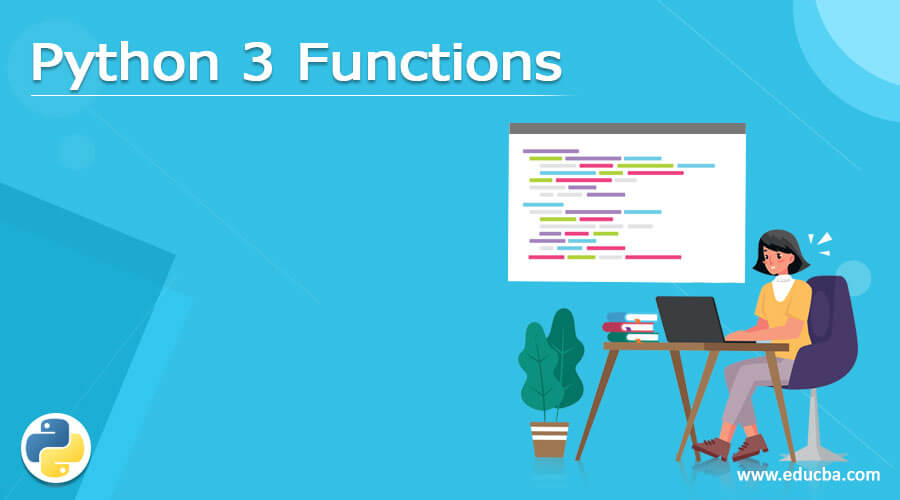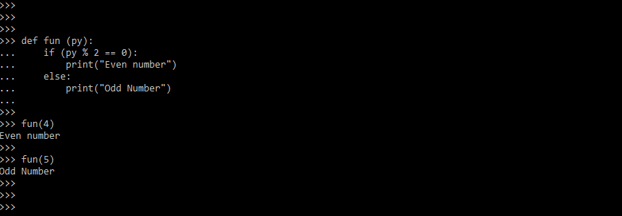Updated July 5, 2023
Definition of Python 3 Functions
Python 3 functions are reusable, ordered chunk of code that performs the single, connected activity. Functions provide our program with more modularity and allow us to reuse a lot of code. As we are aware, Python includes a number of built-in functions such as print, but we may also construct our own. User-defined functions are what they’re called. Functions can be defined to offer the desired functionality. In Python, we define functions using rules.
What is python 3 functions?
- The function name is followed by parentheses (()) and the keyword def. Within this parenthesis, arguments and input parameters will go. Within this parenthesis, we can additionally specify parameters.
- String function of documents, often known as the doc string, can be the initial statement of a function.
- Every function has an indented code block that begins with a colon (:). Return expression of statements departs a function, with the caller receiving an optional expression. The same as return none if we have pass return statement without parameter.
Below is the syntax of function in python 3 is as follows.
Syntax:
def name_of_function (parameters) :
"Docstring of function"
function suite
return expression- The name of the function is used to identify it. The same criteria apply to naming functions in Python as they do to naming identifiers.
- We can pass function values by using parameters. They’re not required. The function header is terminated with a colon (:).
- The function body is made up of single or multiple statements of python. Indentation levels for all statements must be the same.
Below is the Python 3 built-in function is as follows.
1. Int – This function is used to converts string data type to an integer.
2. Print – This function is used to prints an object to the terminal.
3. Len – This function is used to calculate the length of string.
- Parameters contain the by default positional nature, and we just need to inform them in the order in which they were defined.
- Function in python is a piece of code that only executes when called. A function can accept data in the form of parameters. The outcome of a function can be data.
- A function is nothing but a set of instructions that performs a certain task and can be reused after it is defined. Functions make programming more modular by allowing us to reuse code. Parentheses and parameters are sometimes used in function names.
Creating python 3 functions
- A function in Python is collection statements that accomplish a single task. Our program can be broken down into smaller, modular portions with the help of functions. Functions help our program become more ordered and controllable as it grows larger.
- The concept is to group together some often performed actions and create a function so that, rather than writing the same code over and over different inputs, we may call the function and reuse the code it contains.
- Both built-in and user-defined functions are available. It aids in keeping the program short, non-repetitive, and well-organized.
- The below example shows creating simple functions in python are as follows. We are creating function names as fun and calling the same are as follows.
Code:
def fun():
print("python 3 function")
fun()Output:
- We can create a python function by using a def keyword. Also, we can call the function by using function name. We can also pass the function parameter at the time of creating the function in python.
- In the below example, we will create a basic function to determine whether the integer which was we have provided is odd or even.
Code:
def fun (py):
if (py % 2 == 0):
print ("Even number")
else:
print ("Odd Number")
fun(4)
fun(5)Output:
Type’s of python 3 functions Arguments
Below is the type of arguments available in python 3 is as follows. We can call them by using this argument.
1. Required arguments
- The parameters supplied to a function in the proper sequence are known as required arguments. The number of arguments in the function call must exactly match the number of arguments in the function definition in this case. We must always supply one argument to the function.
Code:
def py_fun (py1, py2 = 20):
print ("py1: ", py1)
print ("py2: ", py2)
py_fun (10)Output:
2. Keyword arguments
- The function calls are tied to the keyword arguments. When the caller refers to the parameter name to identify the parameters.
- Because the Python interpreter might utilize the keywords parameters, we can skip arguments or put them in the wrong order.
Code:
def py_fun( py1 ):
"Python 3 function"
print (py1)
return
py_fun( py1 = "Python function")Output:
3. Default arguments
- If a value is not specified in call of function for an argument, it assumes a default value. The below
- The example shows default arguments in the python 3 function are as follows.
Code:
def py_fun ( stud_name, stud_age = 12 ):
"Python 3 function"
print ("Stud_name: ", stud_name)
print ("Stud_age ", stud_age)
return
py_fun ( stud_age = 10, stud_name = "ABC" )
py_fun ( stud_name = "PQR" )Output:
4. Variable length arguments
- It’s possible that we will need to run a function with arguments provided when we created it. Variable-length arguments are those that aren’t named in the function declaration.
Code:
def py_fun ( py1, *py_tuple ):
"Python 3 function"
print ("Output: ")
print (py1)
for tup in py_tuple:
print (tup)
return
py_fun(15)
py_fun(75, 65, 55)Output:
Examples
Below is the example of python 3 arguments are as follows.
Example #1
In below example, we are creating a function name as py_fun.
Code:
def py_fun (py):
return py + 1
print (py_fun(25))
print (py_fun(35 + 55))Output:
Example #12
Below example shows python 3 function with range function are as follows, In following example we are creating function name as py_fun.
Code:
def py_fun (py):
print("Inside the testfunction")
sum = 0
for py1 in range(py):
sum += py1
return sum
py_fun (10)Output:
Conclusion
The name of the function is used to identify it. The same criteria apply to naming functions in Python as they do to naming identifiers. Python 3 functions is reusable, ordered chunk of code that performs a single, connected activity. String function of documents, often known as the doc string.
Recommended Articles
This is a guide to Python 3 Functions. Here we discuss the definition, What is python 3 functions, examples with code implementation. You may also look at the following articles to learn more-











